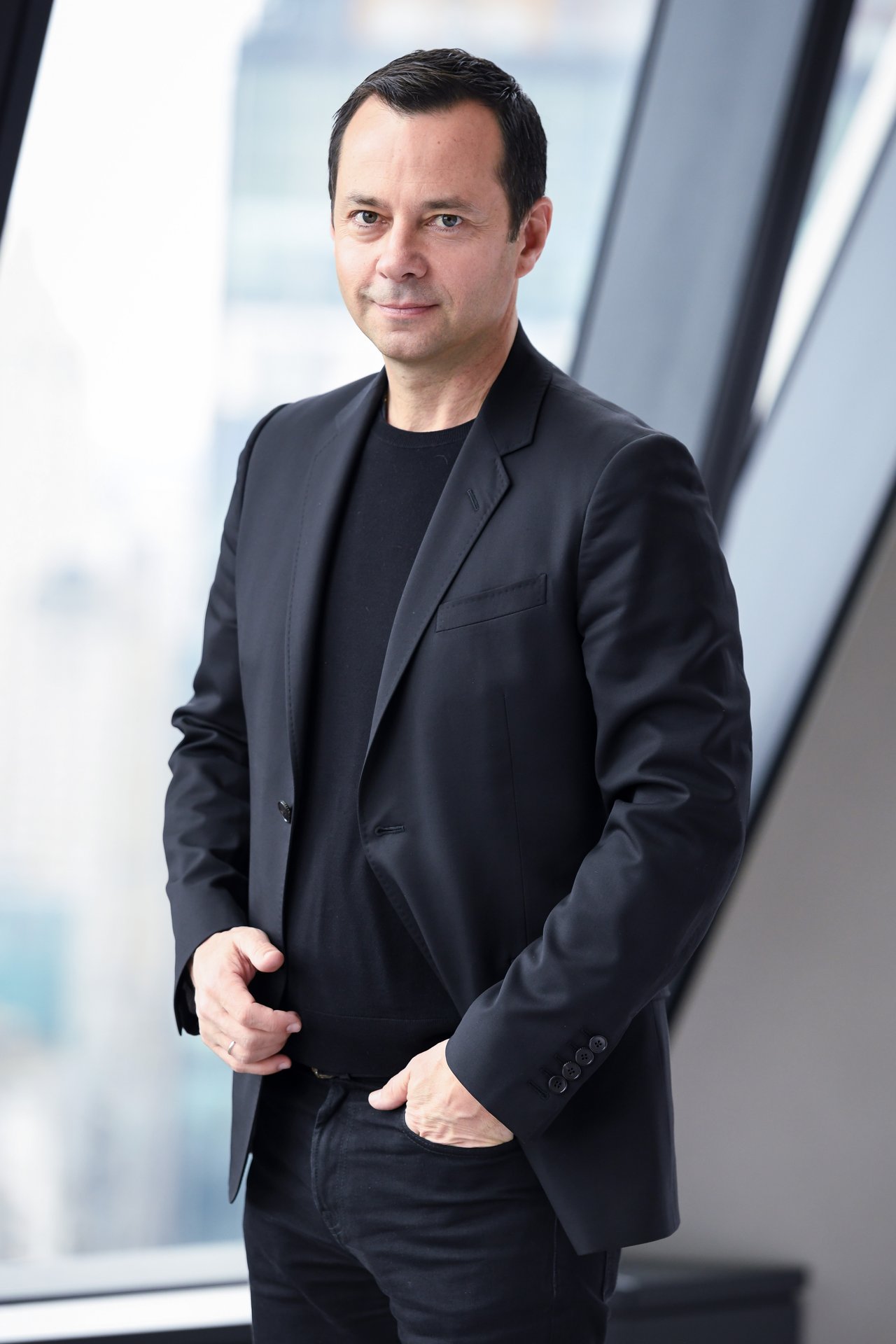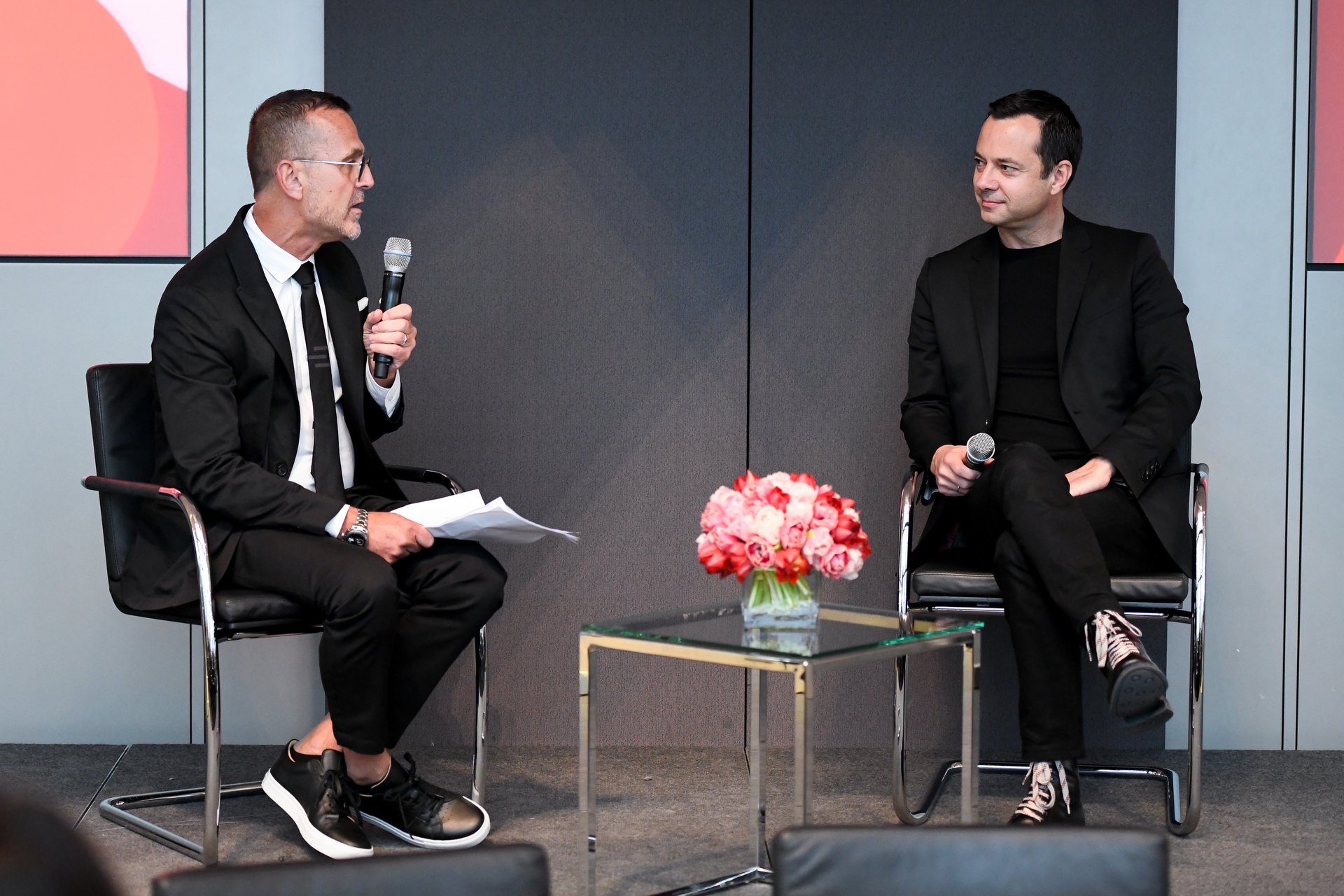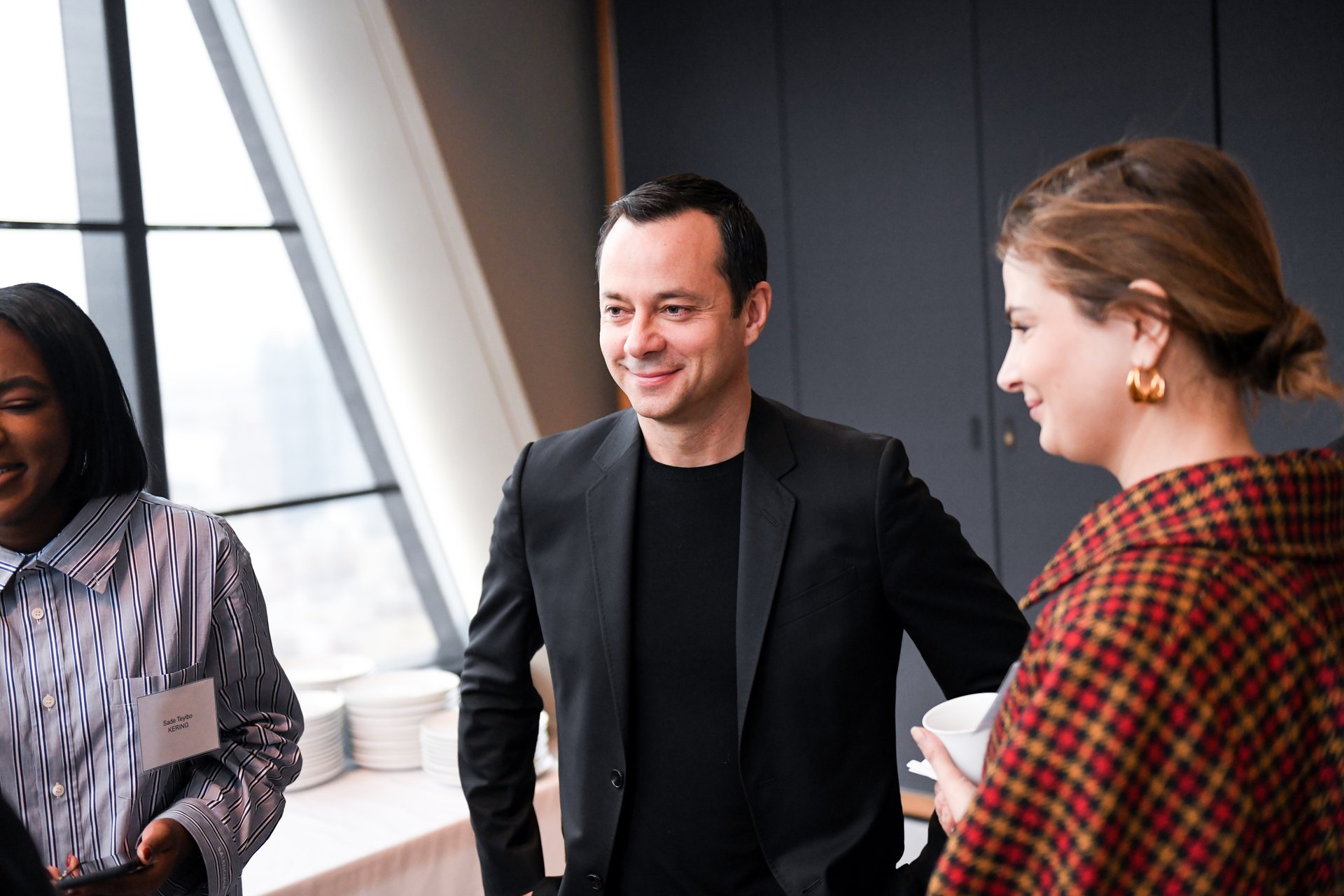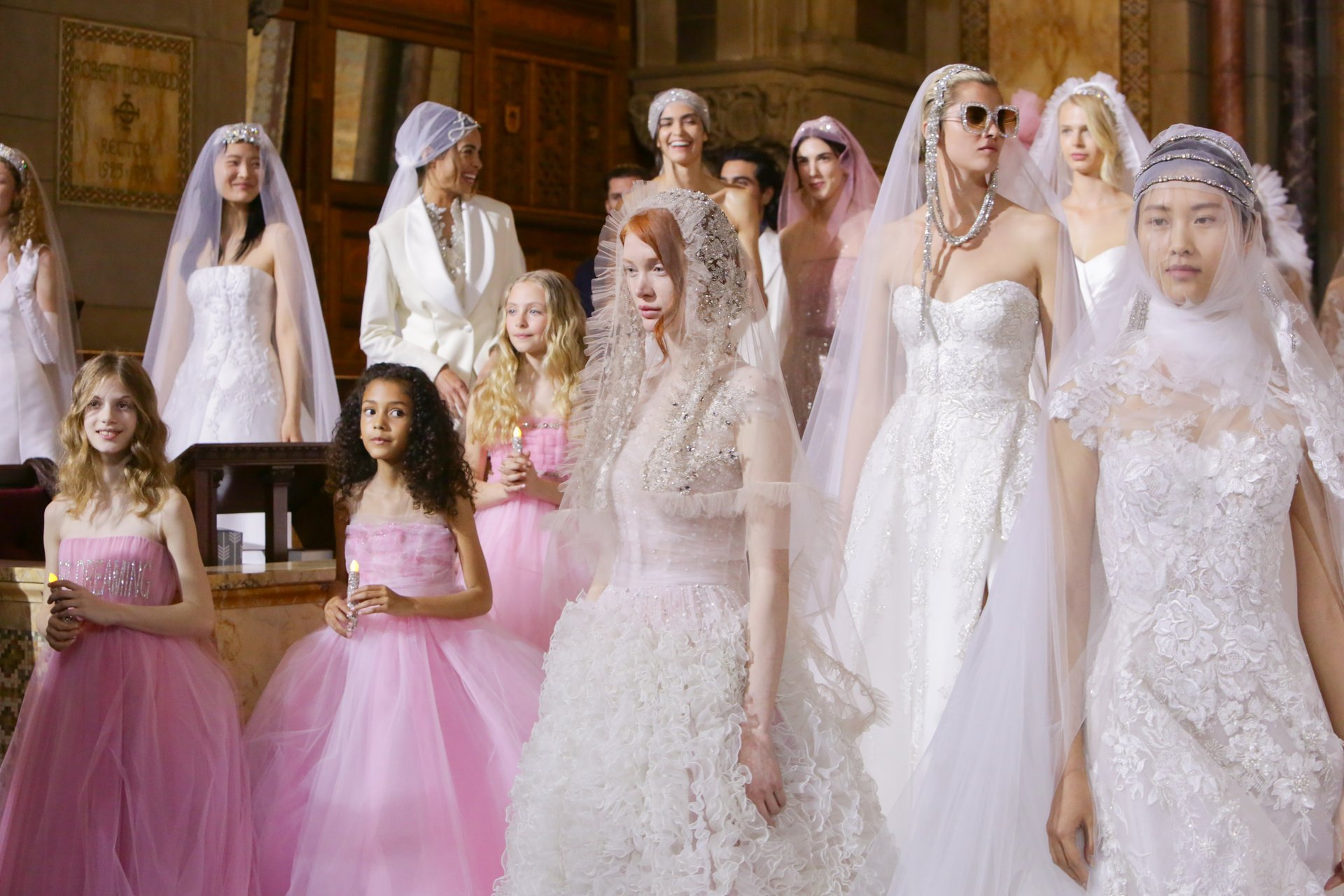Laurent Claquin of Kering and Steven Kolb Kick Off the 2019 CFDA Fashion Leadership Conference
April 12, 2019
Shyam Patel

In the age of fashion’s ethical awakening, terms like sustainability, diversity, inclusion, and innovation often feel like superficial buzzwords. When used by Kering Americas President Laurent Claquin, they’re clearly defined imperatives that have the power to both bolster business and enact crucial change. In a keynote conversation to over 100 industry insiders gathered at Hearst Tower for the second annual CFDA Fashion Leadership Conference, the New York-based French executive outlined Kering’s extensive environmental and social programs executed by decisive governance. Moderated by CFDA President and CEO Steven Kolb, the conversation touched on the luxury group’s pivotal Environmental Profit & Loss Account, its dedication to the advancement of women, and moments of growth including Gucci’s swift action in the wake of its blackface controversy.
No matter the initiative, from investing in textile and retail innovation to including diverse perspectives in company culture, Claquin insisted that change must come from the top. “Our CEO and chairman Francois-Henri Pinault is convinced that we have to do things differently,” he said, later noting the importance of company leaders accelerating progress. Even then, large, monied conglomerates like Kering are in a unique position to implement responsible practices. For the smaller brands that want to make a difference, Claquin offered up the company’s online open source materials and encourages dialogue with vendors. But no matter the size of one’s business, “It’s very important to do things when no one is looking,” Claquin asserted. “Not when it’s trendy.”
Read an abridged version of the 2019 CFDA Fashion Leadership Conference’s keynote conversation below.

Laurent Claquin
Steven Kolb: Can you explain how Mr. Pinault’s vision trickles down and influences everyone in the company and at the brands?
Laurent Claquin: Kering is a group of luxury brands listed on the French stock exchange in Paris, but it’s also family-owned and controlled. The family values have become the company values. In our case, it really starts from the top. Our CEO and Chairman Francois-Henri Pinaultis convinced that we have to do things differently. Everyone knows what the situation is now in terms of the growing population, the limited resources… and [sustainability] is not an option, it’s a necessity.
We approach sustainability in a very pragmatic way by defining precise, measurable objectives, by having a precise governance to implement it. For us, it also makes business sense because it brings [about] creativity and innovation.
SK: I was recently speaking with a designer in luxury and they said that they don’t think that the consumer cares about sustainability and that they’ll pay whatever to get the most nice thing no matter what the impact. Do you think that the luxury shopper cares about sustainability?
LC: For us, sustainability is just quality. We don’t do it to sell another bag. We do it because it’s the right thing to do. I believe that in the luxury industry that is not the first criteria. I think you buy a dress or jacket because you love the cut, the material, the design, and the brand. [Sustainability] is becoming more important, but it’s not first.
By being responsible, you don’t get points. You actually get a negative impact if you don’t do it, but you don’t get credit for doing it. It’s slowly changing, especially with the younger generation. I just read a study by Nielsen saying that 73 percent of millennials are willing to spend more on products coming from brands with sustainable values.

Steven Kolb and Laurent Claquin.
SK: Kering has implemented what is called the 2025 Sustainability Strategy. Can you explain its three pillars Care, Collaborate, and Create?
LC: We started it in 2007. It’s a very holistic approach. We’re looking at the environmental and social point of view, innovation, and community. We’re defining precise and measurable objectives. We started by doing an Environmental Profit and Loss account, or EP&L. The methodology is an open source on our website. It was a very long process because we are giving a monetary value to the total impact across the supply chain. It’s not only about operations. We go back to the extraction and the [refining] process of the raw material. It’s not really about the money. It’s to help us prioritize and make decisions. So we measure the Co2 emissions, water consumption, pollution, waste that ends up in a landfill, etc. Up to 80 percent of the impact is [connected to] the raw materials. Therefore, a majority of our programs focus on the raw materials. That’s what makes the difference.
Sustainability is not a side project or philanthropy. It has to be embedded into the business model and the products. We have the Kering standards for raw materials and the manufacturing process. Again, this is a very long, open source document on our website. There’s a lot of information about where to source from.
It’s also a part of our structure and governance. Today, we have more than 50 people working on sustainability at Kering alongside a team of experts on conservation and energy, both at Kering and at the brands. Since 2010, 10 percent of the compensation of the CEO is linked to the achievement of these objectives.
SK: How can smaller brands translate what Kering has done to their companies?
LC: Well, there is the EP&L and it assesses the cost that we have to pay if we had to pay nature. There is also a seven-step approach on the website that actually helps us. If you don’t want to go that far, just be very pragmatic and talk to your suppliers. It’s really about [addressing] waste associated with raw material and process.
I would also say that every little step is important from not using plastic bottles to reducing air conditioning use. No step is too little. If everyone changes together, we can have a big impact.
SK: Do you have a material index that creatives can use?
LC: We have a material innovation lab based in Milan where we have gathered over 3000 fabrics that we consider sustainable. All the brands can tap into that. We also make [sources] for a tanning process that eliminates heavy metals like chrome available to the competition because we believe in transparency and open sources.
SK: Is there one Kering brand that’s more progressive with sustainability?
LC: We have umbrella programs that everyone can benefit from. The philosophy at Kering is what we call freedom within a framework. We give the brands a lot of autonomy and freedom, but we also provide a framework and this is one of them. Some these policies are mandatory.
Gucci is really moving the needle because of its size. They have a very impressive [sustainability] program. They have a site called Gucci Equilibrium where they talk about their different initiatives.
SK: Can you explain what Kering has done to address women’s equality? I believe 63 percent of the
Kering workforce is made up of women and 64 percent of the board is women. How did you achieve that and where does that commitment come from?
LC: It was also one of the concerns of our chairman and CEO Francois-Henri Pinault, so it starts from the top. It was his own personal and professional conviction that diversity and equality at every level of the organization is absolutely crucial. The key to our success is our dynamic and multicultural workforce. It was a very pragmatic approach when it came to women’s [issues]. We looked at the numbers. More than 60 percent of the workforce is female and 80 percent of our clients are women, so we wanted to give back to the community. This is a population that suffers discrimination and injustice in many ways. We have a program called Kering For Women which has three pillars. The first one is internal. We have a lot of programs that address gender equality in terms of equal opportunity and equal compensation within the company. One of them is a 14-week maternity leave for all women, everywhere we operate. In the U.S. we just tested an emergency child care program so there’s a lot of initiatives related to work-life balance.
Then we have our foundation that we created 10 years ago. It fights sexual and domestic violence against women. We work with international and local NGOs, social entrepreneurs, and a lot of very comprehensive programs. Also, there’s very important advice for smaller companies—do it in a very authentic way. It’s very important to do things when no one is looking, not when it’s trendy.
Lastly, we have what’s almost become a movement called Women In Motion, which advocates for the representation of women in the art and film industries.

Laurent Claquin
SK: A year ago, we did a study with Glamour called The Glass Runway. It looked at gender and the opportunities that women have in our industry. It was interesting because in an industry that caters to a female customer, there is a challenge for women to grow within the industry. Studies showed that it was easy for women to get into the industry, but they eventually plateaued. This had to do with work-life balance. What you’re doing at Kering has been successful. To have more women than men in the company is incredible.
I’m also impressed by the response that Gucci had with the sweater. I thought the way the company addressed that quickly with programing and outlining specifics to have more diversity and inclusivity is pretty impressive. Can you talk more about that?
LC: We took it very seriously. Marco Bizzarri, the CEO of Gucci, came to the U.S. right away to meet with Gucci employees and different communities. We immediately acknowledged that it was a mistake and was not intentional, but also that we had to fix that and ensure it doesn’t happen again. The response had a really comprehensive program around diversity and inclusion both within the company globally and with schooling through scholarships and exchange programs. There’s also a commitment to recruit people from diverse [backgrounds] because we realize that it is diversity and inclusion that makes the difference.
I was participating in a workshop at the CFDA where it was explained that diversity is the thread, but inclusivity is the needle. So you not only have to have all of these people around the table, but they have to have a voice. The network that Gucci has built over the last 20 years with various communities became useful to the company culture. I can’t talk for the brand, but what Marco has said that the company culture is the most precious thing Gucci has: It’s easy to copy a sneaker, but company culture takes a lot of time to copy. All of these different programs they’ve put in place for many years, really served as a foundation to address such an issue. We always want to improve and get better.
SK: The CFDA workshop you referenced—which we worked on with PVH and Manny Chirico—was really the beginning of a briefing we did at the start of the year called Insider/Outsider. When we were uptown in Harlem, where Dapper Dan hosted Marco [Bizzarri], there were over 40 industry people there. At the meeting, it was said, “take a week or two to figure out your response and strategy.” Within 36 hours, you had already made commitments and movement. I think gender inclusivity and diversity are hot topic words we hear a lot in the industry, but at the CFDA and at Kering, it’s not just words, it’s action too. Tell us about your partnership with Fashion For Good and Plug And Play Accelerator.
LC: There’s an innovation aspect of sustainability. Our strategy is care, collaborate, and create.
Care is about the environment, collaborate is about social initiative, and create is about innovation. If we want to reach our very ambitious target of reducing the EP&L by 40 percent, reducing Co2 emissions by 50 percent, we need breakthrough technology, new materials, and new business models. That’s why we do it internally, but also work with Fashion For Good and Plug And Play Accelerator, which is a program that identifies startups working on innovating raw material and business models. We have mentorship programs to help them develop these [ideas] and work with them to implement the technology. Sometimes it’s too early because we’re working on mushroom leather, seaweed fabric, and orange fiber, but we need these if we want to accelerate our programs.
SK: The health and well-being of models is something that the CFDA has been really focused on for over a decade. You took a very strong position in the Model Charter. Can you explain that?
LC: It was a concern of Francois-Henri Pinault for many years and he felt things were moving too slow. As a leader, you need to push the boundaries and accelerate these kinds of initiatives. We worked with experts and industry people—the charter has been co-written by LVMH. This charter is just the beginning to protect models. It’s a series of criteria and requirements in terms of health, psychological support, working hours, and age. For example, you can’t have a model under 16 years old. For models between 16 and 18, there are very specific conditions in terms of weight and body size. It addresses the working conditions of models.
SK: In fashion we often say that it’s about product first. While it is about product, we’re really talking about people first in these conversations about sustainability, gender, innovation and the model charter. We often don’t show the support for the people that make up our industry. I admire that you’re doing that very much.
PHOTOS BY ZACH HILTY/BFA.COM
Previous

Lela Rose Bridal Spring 2020
